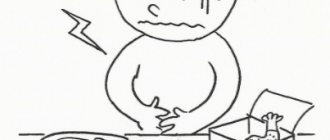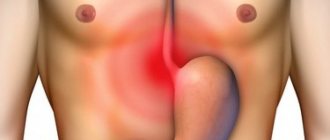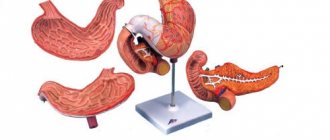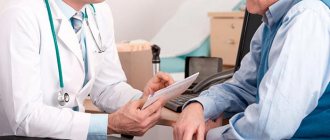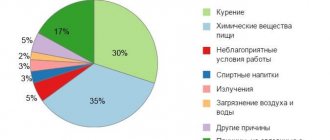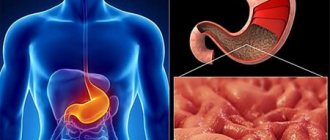How does bile release occur?
Liver cells are responsible for the production of bile in the human body, and the gallbladder is responsible for storing this fluid. Normally, it should immediately flow from it into the duodenum. A special sphincter called the pylorus prevents contents from flowing back into the stomach. Mechanism of bile release:
- If the patient has problems with the gastrointestinal tract, the work of the pylorus is disrupted.
- This promotes the return of bile. Everything happens due to intracavitary pressure, which increases inside the duodenum.
- Under the influence of aggressive bile acids, symptoms characteristic of gastroduodenal reflux occur.
Vomiting due to bile reflux
Bile reflux is a condition in which bile flows in the opposite direction - from the duodenum into the stomach. The presence of this fluid causes irritation of the walls of the organ, so nausea and subsequent vomiting are a natural consequence of this pathology. Bile reflux itself is not a disease, but is characteristic of a fairly large number of pathologies of the gastrointestinal tract.
Among the most common causes of its occurrence are stomach and duodenal ulcers. Functional dispersion. Consequence of surgery to remove the gallbladder. Hernia. Tumors in the duodenum. Various conditions associated with disruption of the pylorus - a fragment between the stomach and duodenum. For example, pyloric stenosis can manifest itself with morning attacks of such vomiting.
Bile reflux is a condition in which bile flows backwards from the duodenum into the stomach.
Bile reflux cannot be ignored; if these symptoms occur, you should definitely consult a doctor. The fact is that this condition is not only a sign of diseases of the gastrointestinal tract (GIT), but can also provoke a chronic form of inflammation of the stomach walls - reflux gastritis.
Since bile reflux leads to irritation of the walls of the stomach, in addition to vomiting, it is accompanied by other symptoms, including:
- pain in the upper abdomen;
- sour taste in the mouth; heartburn;
- cough and hoarseness.
You should definitely call a doctor. Before his arrival, you can alleviate the condition by washing your stomach. To do this, you need to drink 2-3 liters of clean water and induce a gag reflex. After rinsing, rinse your mouth and drink a few sips of cold water. This can be done if vomiting is caused by poisoning or alcohol intake. If the cause is unknown, it is better to wait for doctors to arrive.
Repeated vomiting leads to dehydration, so the patient must often be given liquid: rosehip decoction, weak tea, still water. Drink liquid only in small sips to avoid recurrence of vomiting. Before the doctor arrives, you need to ensure peace, preferably sleep. Vomiting can accompany serious diseases - myocardial infarction, strokes, exacerbations of chronic diseases of the liver and pancreas. Self-medication for such diseases is unacceptable!
Why is bile in the stomach dangerous?
A similar condition sometimes occurs even in people who do not have health problems, but not more than once every 2-3 weeks.
More often this happens due to eating poor quality food.
There's no reason to worry here. Only constant stagnation of bile in the stomach requires consultation with a doctor. The regular appearance of bitterness in the mouth and sour belching may indicate such a pathology.
Reflux is dangerous because the gastric mucosa is irritated by bile acids. First, because of this, burns appear on the shell of the organ, which over time cause the development of ulcers and complete erosion of the walls. When there is a lot of bile in the stomach, without treatment the following may develop:
- acute gastritis;
- peptic ulcer;
- oncology of the digestive tract.
Which doctor should I contact?
Increased secretion of bile into the stomach is a symptom that requires consultation with a doctor. At the first stage, this may be a therapist who will confirm the fact of bile reflux and refer you to a specialist.
If you notice symptoms, contact a gastroenterologist
But it is better to immediately go to an appointment with a gastroenterologist - the doctor will prescribe all the necessary tests, confirm the diagnosis and prescribe treatment.
Why does bile enter the stomach?
Gastroduodenal reflux occurs after resection of the gallbladder. Another risk factor is increased pressure in the duodenum or weakening of the sphincter. Specific reasons for the release of bile into the stomach:
- damage to the gastrointestinal tract during surgery;
- obesity;
- pregnancy;
- obstruction of the bile ducts;
- cholecystitis;
- chronic duodenitis;
- liver diseases, including hepatitis;
- sleeping on the left side after overeating at night;
- abdominal trauma with damage to the muscles of the digestive tract;
- taking medications, including antispasmodics and muscle relaxants;
- oncological diseases;
- smoking;
- exercising after meals.
Articles on the topic
- Choleretic drugs - effective remedies with descriptions and prices
- Causes of bitterness in the mouth in the morning or after eating - treatment methods
- Symptoms of biliary dyskinesia - signs of the disease
Dietary recommendations
The diet should be followed not only during treatment, but also after its completion.
The nutritional instructions are as follows:
- Avoid smoked, fried and fatty foods. This will help reduce the number of bile reflux into the stomach and intestines.
- Eat foods that coat the stomach walls. Preference should be given to slimy soups and porridges.
- Maintain a dietary regime. You need to eat at the same time, with an interval of 3-3.5 hours. The last meal is no later than 20:00.
You can't eat at night. If hunger does not subside, you can drink 150 ml of low-fat sour milk. It is not recommended to drink food with water or tea.
Recommended Products
The table contains foods that you should include in your diet.
Table 9. What should you eat?
| Product | Daily value (g) |
| 150-200 |
| 50-100 |
| 60-120 |
| 250-350 |
| 200-250 |
Note! Regular consumption of these foods helps normalize bowel movements and prevent the formation of sediment in the gallbladder.
Essential vitamins
If bile is released into the stomach or intestines, it is necessary to enrich your diet with foods rich in vitamins E and B1.
Thiamine helps normalize the acidity of gastric juice, the motor function of the stomach and intestines. The daily requirement of vitamin B1 is 1.3-2.5 g.
Pistachios contain the most vitamin B1
Vitamin E is an excellent antioxidant. The daily norm is 15-16 mg.
Sunflower oil contains the most vitamin E
Symptoms
The walls of the stomach, under the influence of bile acids, are deprived of protective mucus. At an early stage, this manifests itself as heartburn and severe thirst. Patients talk about abdominal pain without a specific localization. The pain syndrome has different intensity. Other characteristic symptoms of gastroduodenal reflux:
- Sensation of bitterness in the throat and mouth. It is especially pronounced when a person is hungry, i.e. on an empty stomach.
- Frequent heaviness in the projection of the liver (right hypochondrium). The most unpleasant symptoms are felt in the navel area.
- Sour belching. Appears due to the abundance of gases that are released with bile.
- Feeling of fullness in the abdomen. It torments a person immediately after finishing a meal.
- Attacks of vomiting. It always contains bile impurities. In this way, the body tries to cleanse the stomach.
Causes
When a person does not eat and is engaged in other activities, the gallbladder is in a state of calm. One gall valve clears the hole, and the second is closed, and its contents cannot enter the cavity of the digestive organ. In a calm state, bile accumulates in the cavity of the bladder and comes out only when needed. The moment of bile release is the entry of food into the stomach. The gallbladder contracts, its valves open and as a result its contents enter the stomach.
Factors that provoke the release of bile:
- dyskinesia of the biliary system,
- poor functioning of the hepatobiliary system.
The first reason is uncoordinated contractions of the walls of the bile bladder and a malfunction in its motor functions with the Oddi valve. Thus, excessive activity of the gall bladder or its insufficient work may be observed. The sphincter of Oddi is a valve on the inner wall of the duodenum. This valve regulates the passage of bile and gastric juice into the intestines. At the same time, the sphincter performs another function - it prevents food from entering the bile ducts.
The next reason for the stomach to fill with the contents of the gallbladder is liver disease, which causes a malfunction in its functioning, the functioning of the gallbladder and the ducts through which bile exits.
It is the occurrence of the first reason for the discharge of bile that contributes to the fact that it does not enter the intestines in sufficient quantities. The gallbladder works, but due to malfunctions, it does not function correctly, which provokes reflux. For example, the following situation arises: a sufficient amount of bile has collected in the gallbladder, and the organ is ready to release a portion of it to the intestines, but the valve for the exit of bile is closed.
The next situation is when the valve is in a state of calm and is already waiting for filling, but its other valve has not closed, which is why bile flows into the intestine. These disorders occur due to gallstone disorders. Several systems of violations can lead to this process:
1.hyperkinetic,
2.hypokinetic.
The first system of disorders occurs due to increased tone of the walls of the gallbladder, because of this it contracts too much. In the second case, on the contrary, the bubble cannot fully function due to its relaxed state.
Thus, the release of bile occurs due to the inharmonious functioning of the valve and gallbladder. The following factors can also cause this condition:
- food allergies,
- stress,
- disturbance of nervous regulation,
- lack of physical activity,
- irregular meals,
- eating spicy, fried, smoked or fatty foods,
- constant overeating
- Unhealthy Lifestyle,
- hereditary predisposition,
- infections of the throat, nose or ears,
- eating canned food
- food poisoning,
- excess body weight,
- diabetes,
- pathologies of the endocrine system,
- abnormalities in the development of the gallbladder or its ducts,
- history of hepatitis virus,
- chronic duodenitis,
- vital activity of parasites,
- diseases of the duodenum,
- insufficient endocrine regulation in the biliary tract.
How to treat bile reflux
To confirm the diagnosis, FGDS (fibrogastroduodenoscopy) and ultrasound of the abdominal cavity are prescribed. The main direction of therapy is eliminating the cause of the emerging pathology. Only by acting on the root of the problem can you cope with the entry of bile into the stomach. Doctors are taking measures to reduce the symptoms of pathology and restore normal digestion. Main methods of treatment:
- Taking medications. They are required to be prescribed to all patients with bile backflow.
- Dieting. It is also a mandatory part of treatment for all patients with gastroduodenal reflux.
- Surgical intervention. It is performed when reflux cannot be controlled with drug therapy.
Bile neutralizing drugs
All medications prescribed are aimed at reducing the symptoms of reflux. The tablets have a different mechanism of action, but help normalize the outflow of bile. Essential medications:
- Prokinetics: Itomed, Motilium, Cerucal. Medicines accelerate the evacuation of bile from the stomach and improve the functioning of the pylorus. As a result, the biological fluid returns to the duodenum faster.
- Preparations containing ursodeoxycholic acid: Ursofalk, Ursosan. Makes bile enzymes water soluble. This helps reduce the aggressive effect on the gastric mucosa. Additionally, such drugs cope with belching.
- Proton pump inhibitors: Pariet, Nexium, Omeprazole. Reduces acidity where the pylorus is located. This reduces the risk of gastroduodenal reflux. Such medications are more often used for diseases associated with high acidity, for example, gastritis.
- Antacids: Almagel, Maalox. They act on the principle of drugs from the previous group: they reduce the amount of gastric juice, but act more slowly.
- Hepatoprotectors: De-Nol, Venter, Rebamipid. Improves liver function, reducing the risk of bile backflow.
- Enterosorbents: Activated carbon, Smecta. Helps cleanse the intestines.
Diet therapy
Following small meals is necessary to relieve the digestive system. To do this, exclude the following foods from the diet:
- fried, fatty, smoked;
- pickled vegetables;
- hot spices and seasonings.
You need to eat in small portions - 150-200 g. Between meals there should be equal intervals of time, no more than 3-4 hours.
It is better to eat at the same time of day, and to steam, boil, stew or bake dishes.
The diet should include:
- cereal porridge;
- fresh fruits;
- lactic acid products;
- broccoli;
- butter;
- fish;
- lean beef, rabbit, veal;
- omelet and soft-boiled eggs;
- non-acidic berries;
- marmalade;
- rosehip infusion;
- vegetable juices;
- jelly;
- chicory tea.
Surgery
Radical treatment methods are indicated for compression of the duodenum. It could be a hernia or tumor. The operation is often performed using low-traumatic methods. Main types of intervention:
- Laparoscopy. This is a minimally invasive operation that is performed through several punctures in the abdominal wall. The camera and instruments are inserted through them. Rehabilitation is quick, and there are almost no marks left on the skin.
- Laparotomy. During this operation, a large incision is made on the abdominal wall. The intervention is prescribed if it is necessary to remove a large area of the gastrointestinal tract. After such an operation, complications are more likely to occur, and recovery takes longer.
Treatment
After identifying the reasons that provoked the accumulation of bile in the lumen of the stomach, the attending physician begins to develop individual treatment regimens.
The main goals of therapy are:
- stopping the pathological process;
- eliminating side effects from irritation of the gastric mucosa;
- removing excess bile to prevent complications.
Pathology can be cured by:
- Mitigation of its clinical manifestations. To do this, the patient is prescribed appropriate medications, an individual diet is developed, and recommendations are given for lifestyle correction.
- Elimination of the main causes that provoked the reflux of bile into the stomach. This goal can be achieved through the use of antibiotics, choleretic and anti-inflammatory drugs. If necessary, resort to surgery.
Operations
Most pathological conditions that provoke regular reflux of bile into the stomach (with the exception of duodenitis - chronic inflammation of the duodenum) can be cured with surgical intervention.
Operations designed to prevent bile from entering the stomach are divided into:
- Laparoscopic, one of the minimally invasive surgical interventions. During their implementation, tumor tumors and other pathologies are removed through several small punctures in the anterior wall of the abdomen, into which a miniature optical system and surgical instruments are inserted. Laparoscopic operations have a number of advantages: due to the small area of injury, the duration of rehabilitation is significantly reduced and the risk of postoperative complications is reduced.
- Laparotomy – operations of the classical type, requiring a large (15-25 cm) longitudinal or transverse incision to enter the abdominal cavity. The main disadvantages of such operations are the high risk of complications and the long period of postoperative rehabilitation due to the scale of the surgical intervention.
Medicines
To treat patients whose reflux of bile into the stomach is intermittent and short-term, certain medications are used to help reduce the clinical manifestations of the pathology, represented by:
- Proton pump inhibitors (the most popular drugs are Omeprazole and Nexium), which regulate the level of hydrochloric acid in the stomach by blocking the activity of the secreting glands.
- Antacids (preparations "Almagel", "Maalox"), neutralizing the acidity of gastric contents by chemical interaction with hydrochloric acid.
- Prokinetics (their prominent representative is the drug “Motilium”), regulating the motor function of the gastrointestinal tract. Thanks to the strengthening of their contractile abilities, the circulation of bile is significantly accelerated.
- Antispasmodics that effectively relieve pain.
- Medicines that eliminate bile stagnation by enhancing the motility of the gallbladder (these include the drugs “Cholecystokinin” and magnesium sulfate).
- Hepatoprotectors (for example, the drug "Ursofalk"). Thanks to the main active ingredient - ursodeoxycholic acid - they convert bile into a water-soluble form, helping to cope with clinical symptoms: bitterness in the mouth, belching, nausea, heartburn.
Nutrition
For the successful recovery of a patient suffering from frequent reflux of bile into the stomach and to prevent severe complications, it is necessary to strictly adhere to a therapeutic diet that requires:
- Complete refusal to eat fatty, fried and too salty foods.
- During treatment, completely exclude from the patient’s diet products of animal origin, such as fish, meat, and dairy products.
- Consumption of foods that stimulate the production of protective mucus and have the ability to envelop the walls of the main digestive organ. This category of dishes is represented by soups, jelly and slimy porridges.
- Mandatory consumption of vegetables (sweet potatoes, pumpkin, carrots, beets and zucchini): boiled, stewed or steamed.
- Including fresh herbs and dishes made from seasonal fruits in the daily menu.
- Proper organization of nutrition, providing for at least 5-6 meals, consumed at the same hours (portions should be small). Thanks to a constant diet, proper bile secretion will be established in the patient’s body over time.
- Significant limitation of consumed fats (both animal and vegetable), as well as strong broths (both meat and vegetable).
- Complete exclusion from the diet of foods that provoke excessive bile secretion: chocolate, pickles, canned food, smoked foods, alcoholic and carbonated drinks.
- To normalize intestinal function, the patient’s diet should include bran and porridge, and to improve the process of natural bowel movement, prunes, honey, pears and watermelon.
Treatment of bile reflux into the stomach with folk remedies
Alternative medicine methods can only be a complement to official therapy. If the patient begins to use folk remedies, then they must be used throughout the entire course of the main treatment. Examples of effective recipes:
- Mix 1 tbsp. l. dry thyme, immortelle, St. John's wort and plantain. Pour 1 liter of boiling water 2 tbsp. l. collection of herbs, pour into a thermos, leave for 1-2 hours. Strain before use. Drink 0.5 tbsp. 3 times/day.
- Pour 1 cup of boiling water over 1 tbsp. l. dry dandelion roots. Pour into a small saucepan and simmer over low heat for 5-10 minutes. Infuse the drink for 2 hours. Take 2 tbsp. l. every time before meals.
- Pour 1 tbsp into a glass of clean water. l. flax seeds. Pour into a saucepan, and after boiling, simmer over low heat for 15 minutes. Leave for 1-2 hours. Each time before meals, take 1 tbsp. l.
